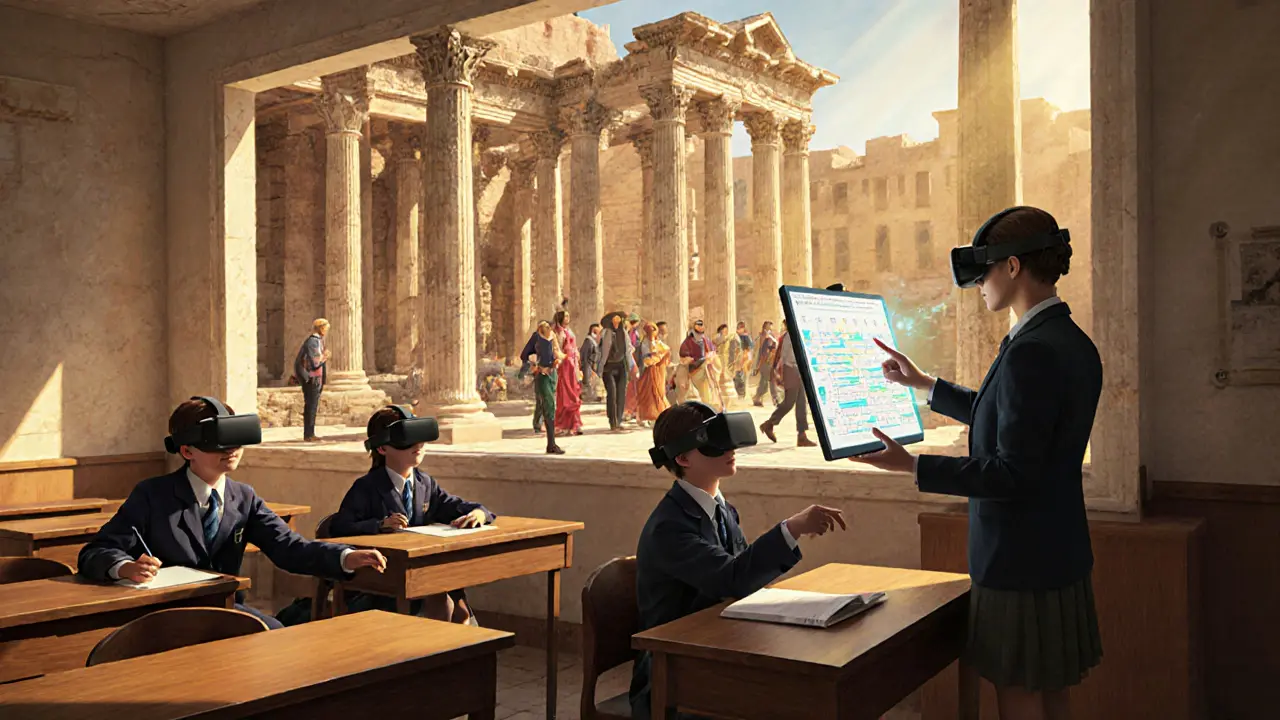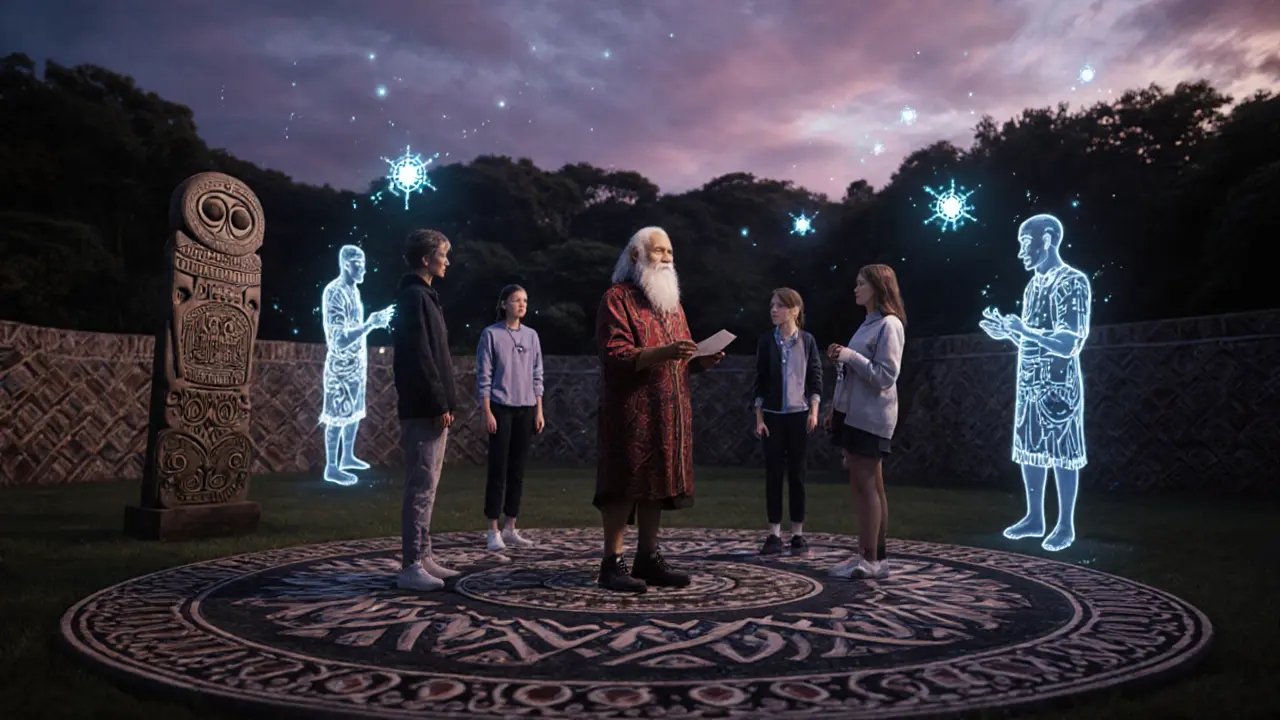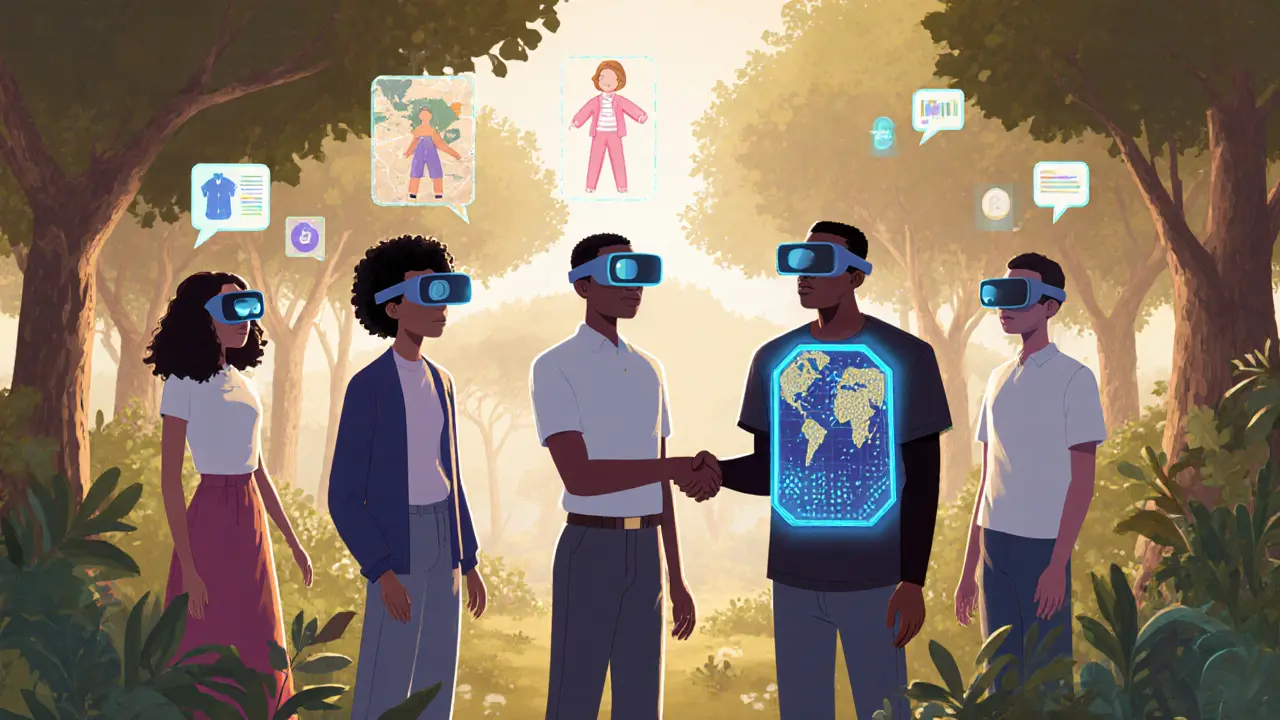Metaverse Asset Value Estimator
Estimate the potential value of your metaverse assets using real-world data from 2025 platforms like Decentraland and Spatial. Based on article insights about blockchain ownership and practical applications.
The metaverse isn’t just science fiction anymore. By 2025, it’s a working part of how businesses connect, how people shop, and even how students learn. But it’s not the flashy, all-in-one virtual world everyone expected five years ago. Instead, it’s becoming something quieter, more practical, and deeply tied to real-world value - especially through blockchain technology.
What the Metaverse Actually Is Today
It’s not one single app or platform. The metaverse is a collection of persistent, shared 3D spaces you can enter through a headset, a phone, or even a browser. You can walk into a virtual store, attend a concert with people from Tokyo and Toronto, or design a product with a team across three continents - all without leaving your living room. What makes this different from Zoom calls or online games? Presence. When you shake hands with someone’s avatar, hear their voice come from the right direction, and see your own digital body move naturally, it feels real. That’s the power of VR and AR working together. And it’s not just for gamers. Retailers like IKEA and Nike have virtual showrooms. Universities run labs in VR. Even small businesses in Wellington are hosting pop-up shops in the metaverse.Blockchain Is the Backbone - Not Just a Buzzword
Here’s the key: without blockchain, the metaverse is just a fancy video game. Blockchain gives you real ownership. When you buy a digital jacket for your avatar, it’s not just a texture file on a server. It’s a unique, verifiable asset - an NFT - stored on a public ledger. You own it. You can sell it. You can take it to another platform if that platform allows it. This isn’t theoretical. In 2025, brands like Adidas and Gucci sell digital clothing that’s traded on open marketplaces. Artists earn royalties every time their NFT art is resold. Land in virtual worlds like Decentraland and Spatial is bought and sold for real money. These aren’t speculative bets anymore - they’re functional parts of a new digital economy. Blockchain also secures transactions. No middleman. No chargebacks. No locked-in currencies. You use crypto wallets like MetaMask or Phantom to pay, and smart contracts automatically handle deals - like paying a designer when your virtual building is finished.The Tech Behind the Scenes
Building a working metaverse needs more than headsets. It needs seven key pieces working together:- VR and AR - VR locks you into a fully digital world. AR adds digital layers to your real surroundings. Together, they let you move fluidly between spaces.
- AI - Your avatar doesn’t just mimic you. AI makes it respond naturally, learn your habits, and even act as a personal assistant in virtual meetings.
- 3D Reconstruction - Real-world places are scanned and turned into digital twins. A coffee shop in Wellington can have an exact copy in the metaverse, down to the smell of beans (simulated, of course).
- IoT - Your smart thermostat, fitness tracker, or car can feed data into your virtual space. Your avatar might sweat if your real body overheats.
- Edge Computing - Processing data closer to you, not in a faraway server, cuts lag. No more frozen avatars during a live concert.
- 5G - Fast, reliable connections make real-time interaction possible. Without it, the metaverse stutters.
- Interoperability - The biggest challenge. Right now, your NFT jacket from Platform A might not work on Platform B. Standards are slowly forming, but it’s still a mess.

Why It’s Not Taking Off Like Everyone Thought
Let’s be honest: most people still think the metaverse is weird. And they’re not wrong - if you’re stuck with a $1,000 VR headset that gives you a headache after 20 minutes, you’re not going to wear it to check your email. Hardware is the biggest blocker. Current headsets are bulky, expensive, and isolating. But that’s changing. Companies like Apple, Meta, and startups in Silicon Valley are racing to release lightweight AR glasses by 2026. These will look like normal sunglasses, overlay maps, messages, or shopping options right in your field of view. That’s when adoption will explode. Another problem? No killer app. People don’t know what to do in the metaverse beyond trying out a virtual concert or buying a digital sneaker. There’s no “TikTok moment” yet. But that’s coming. In education, students are already using VR to dissect virtual frogs or walk through ancient Rome. In corporate training, Walmart uses VR to teach employees how to handle Black Friday crowds. These aren’t gimmicks - they’re more effective than videos or manuals.Who’s Winning and Who’s Falling Behind
Big tech still leads. Meta spends billions on VR hardware. Microsoft’s Mesh platform lets teams collaborate in 3D spaces using HoloLens. NVIDIA’s Omniverse helps architects and engineers build digital twins of factories and cities. But the real innovation is happening at the edges. Startups are building niche tools: one company lets farmers simulate crop growth in a virtual field before planting. Another lets therapists treat PTSD by recreating safe, controlled environments. A New Zealand-based team is creating a metaverse version of local marae for cultural education. The winners aren’t the ones with the fanciest graphics. They’re the ones solving real problems: reducing travel costs, improving accessibility, or creating new income streams for creators.
What’s Next? The Next 5 Years
By 2030, the metaverse won’t be a place you “go to.” It’ll be a layer you live in. Your digital identity - your avatar, your assets, your reputation - will be as important as your real-world ID. Blockchain will protect it. AI will personalize it. And AR glasses will make it invisible. Here’s what’s likely:- Work - Hybrid teams will default to virtual offices. Meetings won’t be on Zoom - they’ll be in shared 3D spaces where you can sketch ideas on virtual whiteboards or pull up 3D product models.
- Shopping - You’ll try on clothes in VR, see how furniture looks in your actual room via AR, and buy digital items that sync with your physical purchases.
- Education - Kids will learn history by walking through recreated battles. Medical students will practice surgeries on digital patients.
- Money - New jobs will emerge: metaverse architects, digital fashion designers, blockchain auditors for virtual land.
Should You Care? Yes - But Not Like You Think
You don’t need to buy virtual land or a VR headset tomorrow. But if you run a business, teach, design, or create - you need to understand this shift. The metaverse isn’t about replacing the real world. It’s about extending it. Think of it like the internet in 1995. Most people didn’t get email. Few had websites. But those who saw its potential - who built tools, learned the rules, and started experimenting - were the ones who thrived. The same is true now. You don’t need to build a metaverse. But you should ask: How can this help my customers? My team? My work? Start small. Try a free VR experience. Create a digital business card. Explore an NFT marketplace. Talk to a developer who’s worked with Web3. You don’t need to be an expert. You just need to be curious. The future of the metaverse isn’t about being immersed. It’s about being connected - more meaningfully, more securely, and more openly than ever before.Is the metaverse just a fad?
No. The hype cycle is over, and that’s a good thing. What’s left are real applications in education, retail, training, and digital ownership. Like the internet in the 1990s, the early years were flashy and confusing. Now, practical uses are emerging - and they’re sticking.
Do I need VR to use the metaverse?
Not anymore. Many platforms work on smartphones and browsers. You can attend events, shop, and socialize without a headset. But for full immersion - like walking through a virtual factory or playing a 3D game - VR still offers the best experience. AR glasses coming in 2026 will change that balance dramatically.
Can I make money in the metaverse?
Yes. People earn income by designing virtual clothing, building 3D spaces, selling NFT art, hosting events, or offering consulting on metaverse strategy. Some developers earn six figures working with companies to create custom virtual experiences. It’s not get-rich-quick, but it’s a real, growing job market.
Is the metaverse safe for kids?
Safety depends on the platform. Some have strict moderation and parental controls. Others are open and unregulated. Just like the internet, you need to choose wisely. Look for platforms with verified identities, content filters, and clear reporting tools. Schools using the metaverse for education are starting to set strict guidelines to protect students.
What’s the biggest risk right now?
Fragmentation. If your digital assets can’t move between platforms, your investment is locked in. Also, privacy is a concern - your movements, voice, and behavior in the metaverse can be tracked in ways you can’t control. Stronger regulations are coming, but for now, be cautious about what data you share.
Will the metaverse replace the internet?
No. It will replace some parts of it - like video calls, online shopping, and gaming - but not everything. You’ll still check email on a screen. You’ll still browse news on your phone. The metaverse will be one layer of your digital life, not the whole thing.

Ali Korkor
October 28, 2025 AT 22:10Yo just tried a free VR museum tour last night and I was blown away. No headset needed, worked on my phone. Feels like stepping into a painting. You don’t need to buy land or NFTs to get value from this stuff. Just play around.
James Young
October 29, 2025 AT 06:33Everyone’s acting like this is some revolutionary breakthrough. It’s just 3D Zoom with extra steps. I’ve seen better graphics in a 2018 Xbox game. The real metaverse is when I can order a pizza from inside my avatar’s living room - not when I’m paying $800 for a digital sneaker that looks like a potato.
Serena Dean
October 30, 2025 AT 08:05James you’re missing the point. It’s not about the tech - it’s about access. A kid in rural India can walk through the Louvre in VR. A teacher in Nigeria can host a virtual science lab without a single beaker. This isn’t flashy. It’s fair.
I’ve seen students with disabilities finally feel like they belong because their avatar moves the way they want. That’s not hype. That’s humanity.
Michael Folorunsho
November 1, 2025 AT 06:38Pathetic. You people are celebrating a glorified Sims mod while real innovation happens in quantum computing and fusion energy. The metaverse is a distraction for the idle rich. Let me know when your digital jacket can keep you warm in winter. Until then, stop romanticizing pixels.
Ayanda Ndoni
November 2, 2025 AT 07:07bro i just wanna chill on my couch and watch netflix why am i supposed to care about some digital avatar shaking hands with a guy from tokyo? i dont even like my own face in zoom calls lol
Elliott Algarin
November 3, 2025 AT 21:34What if the metaverse isn’t about replacing reality but revealing it? When you can feel someone’s presence through a digital handshake, maybe you start noticing how rarely you truly feel present in real life. The tech is just a mirror.
We used to think the internet would connect us. It mostly amplified our noise. Maybe this time, we’ll use the tools to listen instead of shout.
John Murphy
November 5, 2025 AT 00:51i tried the ikea ar app last week put a couch in my living room looked real enough to sit on honestly kinda weird how natural it felt
still dont get why i need blockchain for a digital couch but maybe im just old
Akinyemi Akindele Winner
November 6, 2025 AT 10:58Metaverse my ass. This is just Wall Street with VR goggles. You think a Nigerian farmer gives a damn about NFT fashion? They’re worried about rain and rent. This whole thing is a colonial fantasy dressed in crypto glitter. Let the Silicon Valley bros play with their digital Legos while the world burns.
Patrick De Leon
November 8, 2025 AT 10:37Irrelevant. The real future is in AI-driven automation and robotics. The metaverse is a playground for teenagers with disposable income. Ireland spends billions on infrastructure not virtual land. This is distraction economics at its finest.
MANGESH NEEL
November 9, 2025 AT 13:47YOU PEOPLE ARE ALL BEING MANIPULATED BY BIG TECH AND THE FEDERAL RESERVE. THE METAVESSE IS A DIGITAL PRISON BUILT TO TRACK YOUR EVERY MOVE. YOUR AVATAR IS A SURVEILLANCE TOOL. YOUR NFTS ARE JUST BITCOIN IN DISGUISE. THEY WANT YOU TO THINK YOU OWN SOMETHING BUT YOU’RE JUST A DATA POINT IN A CORPORATE DREAM. THE EU IS ALREADY PREPARING TO DELETE YOUR DIGITAL ID. WAKE UP.
madhu belavadi
November 10, 2025 AT 23:07why do people act like this is new? we had virtual worlds in the 90s. remember second life? same thing. now they just added blockchain and called it innovation. we’re just spinning wheels.
Dick Lane
November 11, 2025 AT 23:06my grandma joined a virtual book club last month. she uses her tablet. talks to people from canada and australia. says it feels like going to church again. i cried. this matters more than any crypto chart.
Norman Woo
November 13, 2025 AT 13:20they say interoperability is the problem but what if its intentional? what if the big boys want you locked in? think about it. meta owns your headset. apple owns your glasses. nvidia owns the engine. who really owns your digital soul? just saying
Chloe Jobson
November 13, 2025 AT 20:23Interoperability is the critical path. Without it, we’re just building walled gardens with better lighting. The W3C’s Digital Identity WG is making progress on cross-platform standards. If we don’t standardize ownership and identity, this collapses into a fragmented mess.
Andrew Morgan
November 14, 2025 AT 10:37just went to a virtual marae in New Zealand last week. elders were teaching genealogy through avatars. kids were dancing. felt like home. this isn’t tech. this is culture staying alive. we’re not replacing the real world. we’re holding space for it.
Zach Crandall
November 15, 2025 AT 21:22Let’s be brutally honest: the metaverse is a $100 billion bet on human loneliness. We’ve outsourced intimacy to avatars because real connection is too hard. The real innovation isn’t in the tech - it’s in our collective refusal to look each other in the eye anymore.
Sean Huang
November 15, 2025 AT 23:22you think this is about tech? no. the deep state is using the metaverse to implant neural tracking via AR glasses. the 2026 release isn’t for consumers - it’s for population control. remember when they said 5G was harmless? they lied. your digital identity is a backdoor to your nervous system. they already have your biometrics from your smartwatch. this is the final step. don’t be the last to wake up.